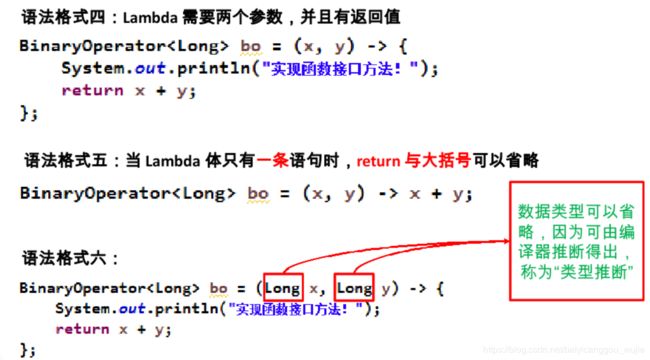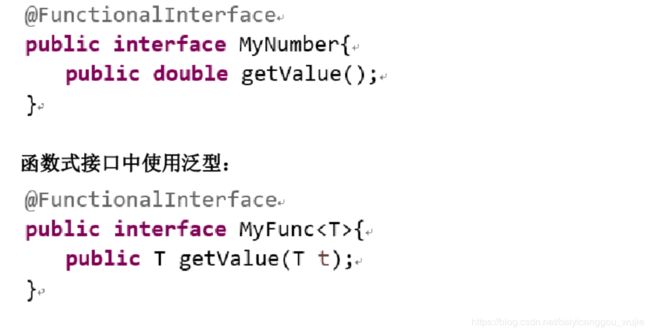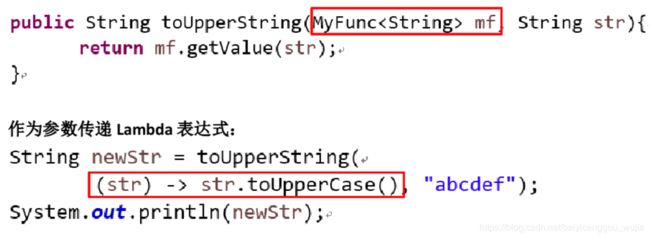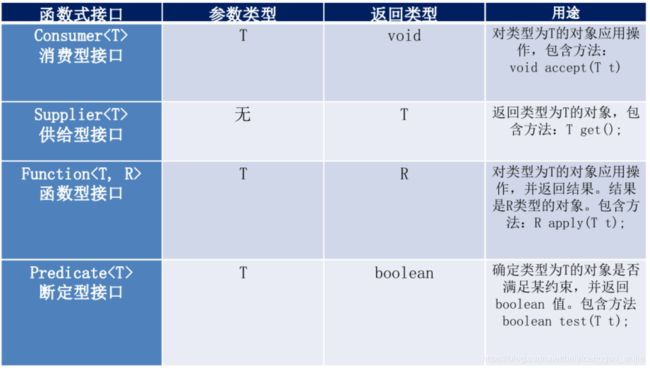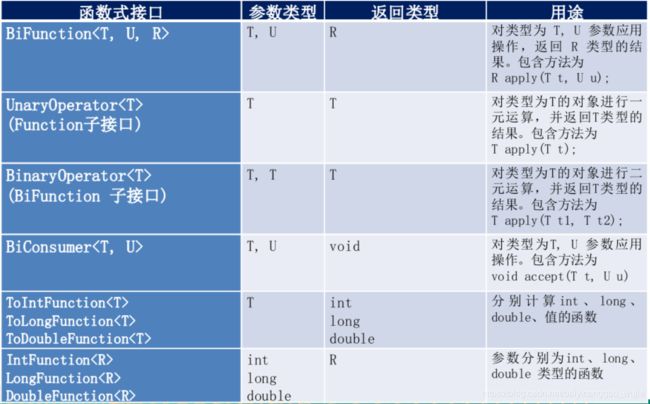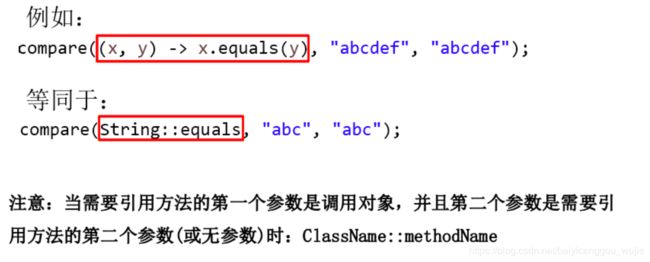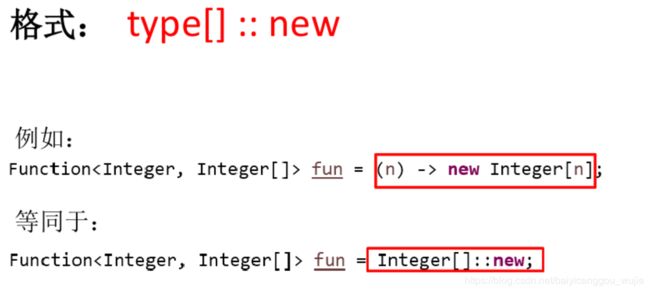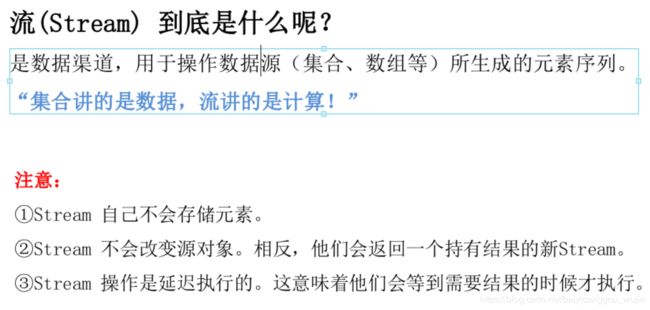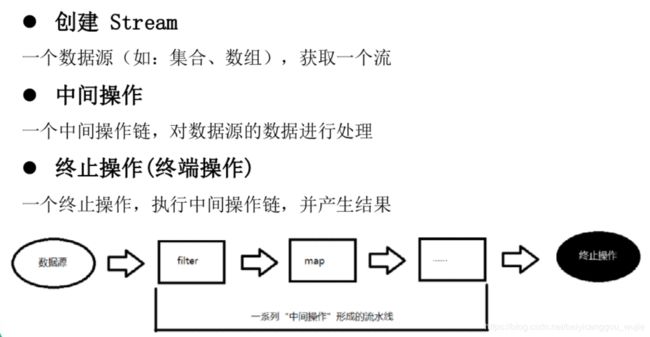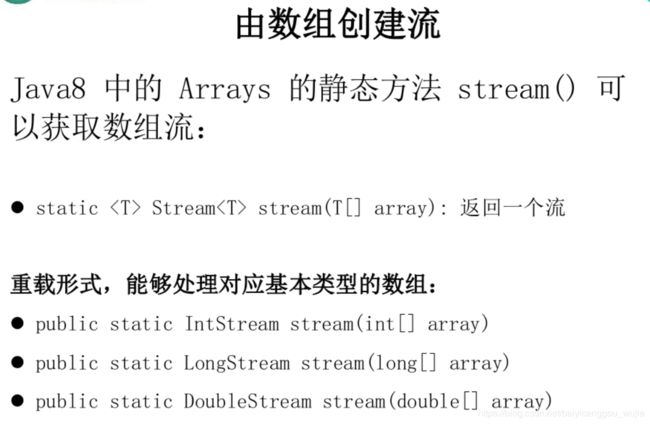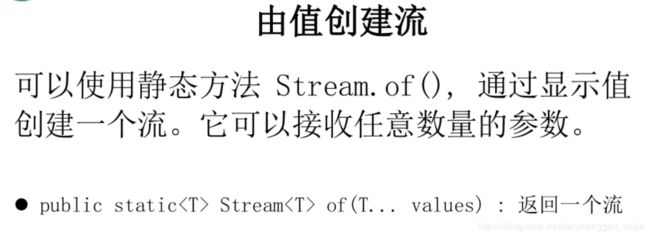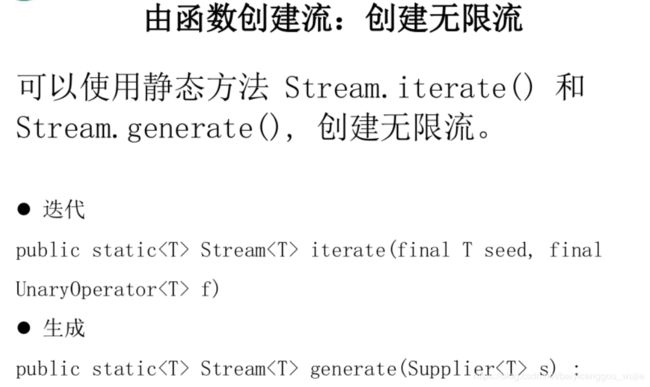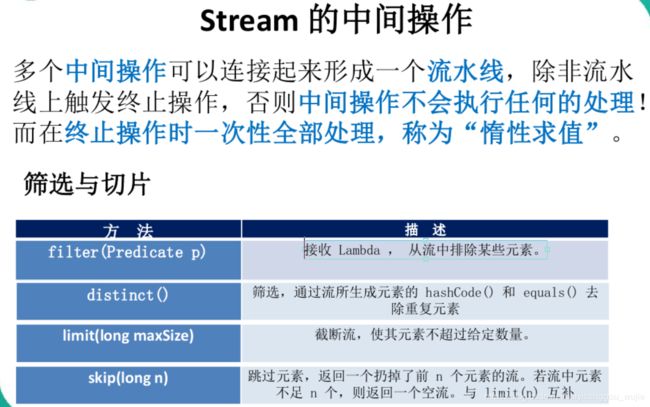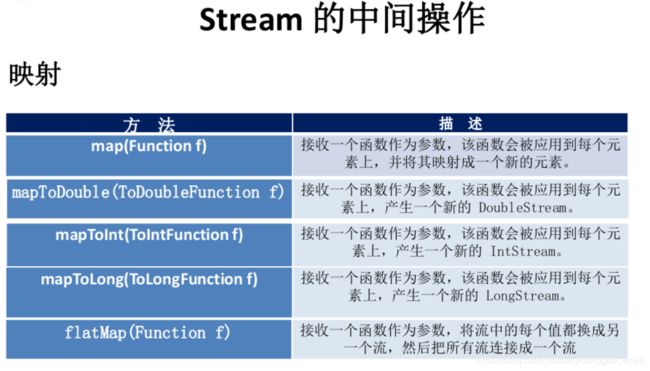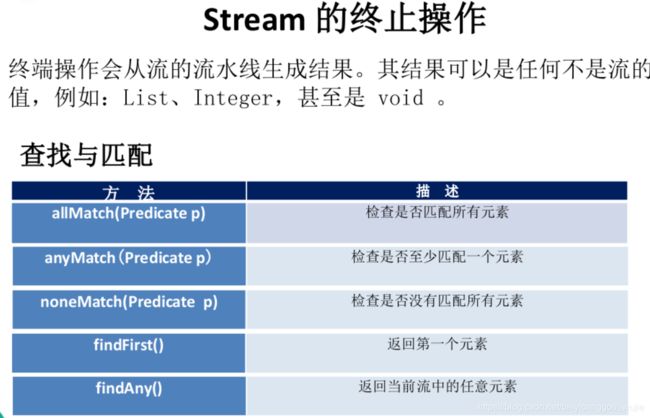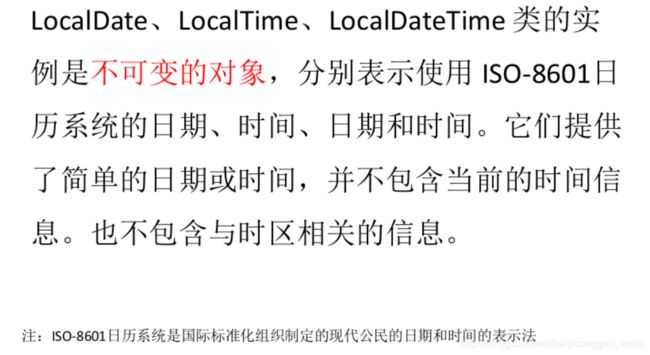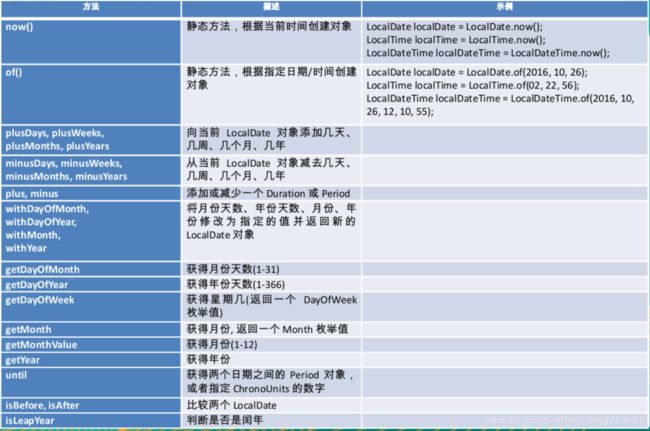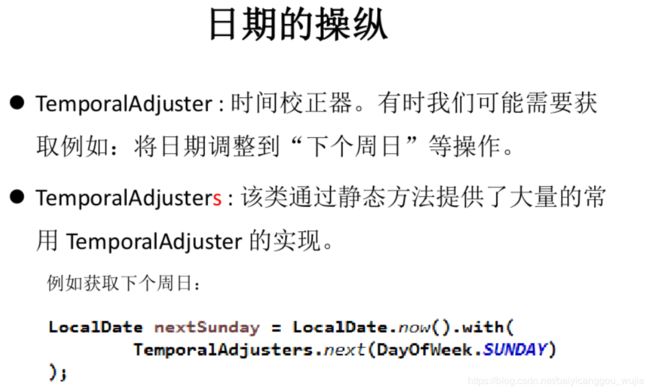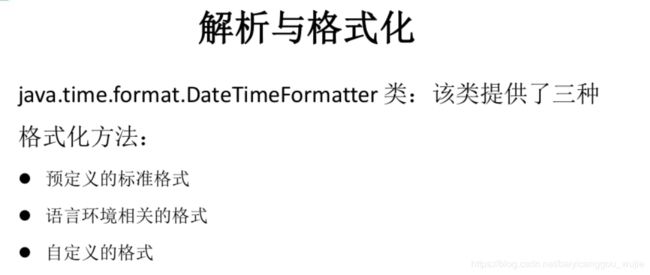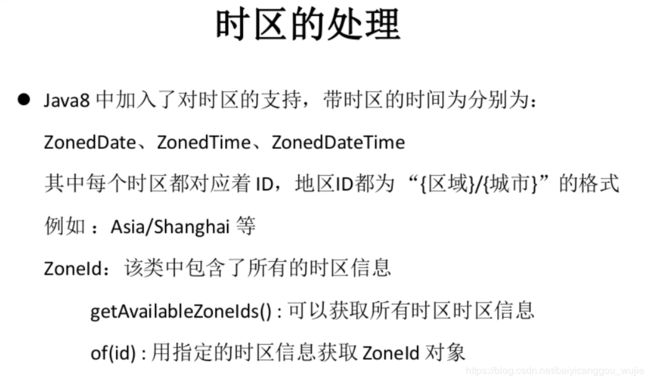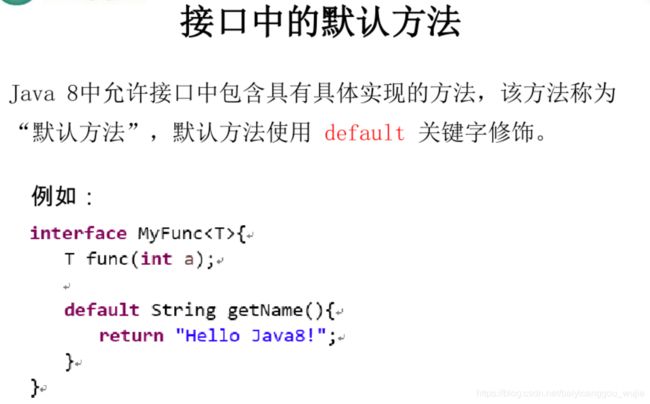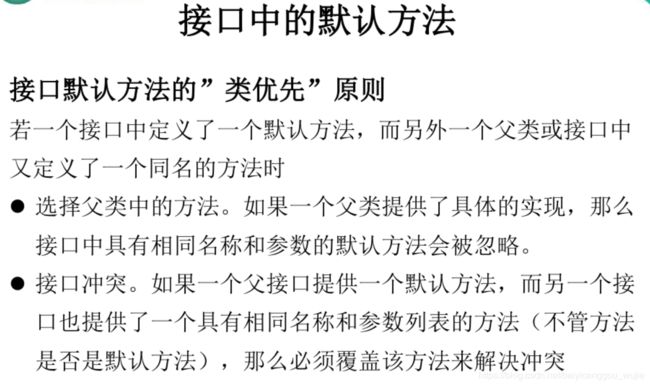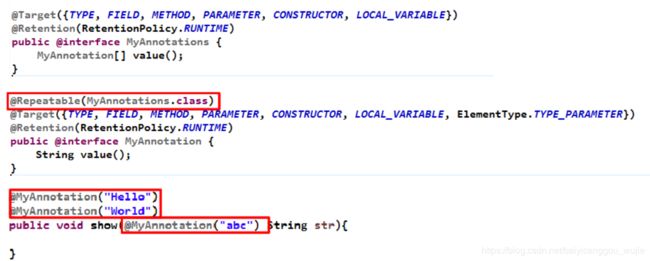Java8新特性总结
Java8新特性归纳如下:
- Lambda 表达式
- 函数式接口
- 方法引用与构造器引用
- Stream API
- 接口中的默认方法与静态方法
- 新时间日期 API
- 并行与串行
- 其他新特性
1. Lambda表达式
- Lambda 是一个匿名函数,我们可以把 Lambda 表达式理解为是一段可以传递的代码(将代码像数据一样进行传递)。可以写出更简洁、更 灵活的代码。作为一种更紧凑的代码风格,使 Java的语言表达能力得到了提升。
- 从匿名类到 Lambda 的转换
@Test
public void test1(){
int num = 0;//jdk 1.7 前,必须是 final
Runnable r = new Runnable() {
@Override
public void run() {
System.out.println("Hello World!" + num);
}
};
r.run();
System.out.println("-------------------------------");
Runnable r1 = () -> System.out.println("Hello Lambda!");
r1.run();
}
- 使用表达式作为参数传递
@Test
public void test1(){
Comparator<String> com = new Comparator<String>(){
@Override
public int compare(String o1, String o2) {
return Integer.compare(o1.length(), o2.length());
}
};
TreeSet<String> ts = new TreeSet<>(com);
System.out.println("--------------------------------");
Comparator<String> com2 = (x, y) -> Integer.compare(x.length(), y.length());
TreeSet<String> ts2 = new TreeSet<>(com);
}
- Lambda 表达式语法
/*
* 一、Lambda 表达式的基础语法:Java8中引入了一个新的操作符 "->" 该操作符称为箭头操作符或 Lambda 操作符
* 箭头操作符将 Lambda 表达式拆分成两部分:
*
* 左侧:Lambda 表达式的参数列表
* 右侧:Lambda 表达式中所需执行的功能, 即 Lambda 体
*
* 语法格式一:无参数,无返回值
* () -> System.out.println("Hello Lambda!");
*
* 语法格式二:有一个参数,并且无返回值
* (x) -> System.out.println(x)
*
* 语法格式三:若只有一个参数,小括号可以省略不写
* x -> System.out.println(x)
*
* 语法格式四:有两个以上的参数,有返回值,并且 Lambda 体中有多条语句
* Comparator com = (x, y) -> {
* System.out.println("函数式接口");
* return Integer.compare(x, y);
* };
*
* 语法格式五:若 Lambda 体中只有一条语句, return 和 大括号都可以省略不写
* Comparator com = (x, y) -> Integer.compare(x, y);
*
* 语法格式六:Lambda 表达式的参数列表的数据类型可以省略不写,因为JVM编译器通过上下文推断出,数据类型,即“类型推断”
* (Integer x, Integer y) -> Integer.compare(x, y);
*
* 上联:左右遇一括号省
* 下联:左侧推断类型省
* 横批:能省则省
*
* 二、Lambda 表达式需要“函数式接口”的支持
* 函数式接口:接口中只有一个抽象方法的接口,称为函数式接口。 可以使用注解 @FunctionalInterface 修饰
* 可以检查是否是函数式接口
*/
public class TestLambda {
@Test
public void test1(){
int num = 0;//jdk 1.7 前,必须是 final
Runnable r = new Runnable() {
@Override
public void run() {
System.out.println("Hello World!" + num);
}
};
r.run();
System.out.println("-------------------------------");
Runnable r1 = () -> System.out.println("Hello Lambda!");
r1.run();
}
@Test
public void test2(){
Consumer<String> con = x -> System.out.println(x);
con.accept("我哈哈哈威武!");
}
@Test
public void test3(){
Comparator<Integer> com = (x, y) -> {
System.out.println("函数式接口");
return Integer.compare(x, y);
};
}
@Test
public void test4(){
Comparator<Integer> com = (x, y) -> Integer.compare(x, y);
}
@Test
public void test5(){
// String[] strs;
// strs = {"aaa", "bbb", "ccc"};
List<String> list = new ArrayList<>();
show(new HashMap<>());
}
public void show(Map<String, Integer> map){
}
//需求:对一个数进行运算
@Test
public void test6(){
Integer num = operation(100, (x) -> x * x);
System.out.println(num);
System.out.println(operation(200, (y) -> y + 200));
}
public Integer operation(Integer num, MyFun mf){
return mf.getValue(num);
}
}
- 类型推断
- 上述 Lambda 表达式中的参数类型都是由编译器推断 得出的。Lambda 表达式中无需指定类型,程序依然可 以编译,这是因为 javac 根据程序的上下文,在后台 推断出了参数的类型。Lambda 表达式的类型依赖于上 下文环境,是由编译器推断出来的。这就是所谓的“类型推断”。
2.函数式接口
- 什么是函数式接口
- 作为参数传递 Lambda 表达式
*
作为参数传递 Lambda 表达式:为了将 Lambda 表达式作为参数传递,接 收Lambda 表达式的参数类型必须是与该 Lambda 表达式兼容的函数式接口 的类型。
- Java 内置四大核心函数式接口
3.方法引用与构造器引用
- 方法引用
- 构造器引用
4.强大的 Stream API
- 了解 Stream
- Java8中有两大最为重要的改变。第一个是 Lambda 表达式;另外一个则是 Stream API(java.util.stream.*)。
Stream 是 Java8 中处理集合的关键抽象概念,它可以指定你希望对 集合进行的操作,可以执行非常复杂的查找、过滤和映射数据等操作。 使用Stream API 对集合数据进行操作,就类似于使用 SQL 执行的数 据库查询。也可以使用 Stream API 来并行执行操作。简而言之, Stream API 提供了一种高效且易于使用的处理数据的方式。
- 什么是 Stream
- Stream 的操作三个步骤
/*
* 一、 Stream 的操作步骤
*
* 1. 创建 Stream
*
* 2. 中间操作
*
* 3. 终止操作
*/
public class TestStreamAPI1 {
List<Employee> emps = Arrays.asList(
new Employee(102, "李四", 59, 6666.66),
new Employee(101, "张三", 18, 9999.99),
new Employee(103, "王五", 28, 3333.33),
new Employee(104, "赵六", 8, 7777.77),
new Employee(104, "赵六", 8, 7777.77),
new Employee(104, "赵六", 8, 7777.77),
new Employee(105, "田七", 38, 5555.55)
);
//2. 中间操作
/*
映射
map——接收 Lambda , 将元素转换成其他形式或提取信息。接收一个函数作为参数,该函数会被应用到每个元素上,并将其映射成一个新的元素。
flatMap——接收一个函数作为参数,将流中的每个值都换成另一个流,然后把所有流连接成一个流
*/
@Test
public void test1(){
Stream<String> str = emps.stream()
.map((e) -> e.getName());
System.out.println("-------------------------------------------");
List<String> strList = Arrays.asList("aaa", "bbb", "ccc", "ddd", "eee");
Stream<String> stream = strList.stream()
.map(String::toUpperCase);
stream.forEach(System.out::println);
Stream<Stream<Character>> stream2 = strList.stream()
.map(TestStreamAPI1::filterCharacter);
stream2.forEach((sm) -> {
sm.forEach(System.out::println);
});
System.out.println("---------------------------------------------");
Stream<Character> stream3 = strList.stream()
.flatMap(TestStreamAPI1::filterCharacter);
stream3.forEach(System.out::println);
}
public static Stream<Character> filterCharacter(String str){
List<Character> list = new ArrayList<>();
for (Character ch : str.toCharArray()) {
list.add(ch);
}
return list.stream();
}
/*
sorted()——自然排序
sorted(Comparator com)——定制排序
*/
@Test
public void test2(){
emps.stream()
.map(Employee::getName)
.sorted()
.forEach(System.out::println);
System.out.println("------------------------------------");
emps.stream()
.sorted((x, y) -> {
if(x.getAge() == y.getAge()){
return x.getName().compareTo(y.getName());
}else{
return Integer.compare(x.getAge(), y.getAge());
}
}).forEach(System.out::println);
}
//3. 终止操作
/*
allMatch——检查是否匹配所有元素
anyMatch——检查是否至少匹配一个元素
noneMatch——检查是否没有匹配的元素
findFirst——返回第一个元素
findAny——返回当前流中的任意元素
count——返回流中元素的总个数
max——返回流中最大值
min——返回流中最小值
*/
@Test
public void test3(){
boolean bl = emps.stream()
.allMatch((e) -> e.getStatus().equals(Status.BUSY));
System.out.println(bl);
boolean bl1 = emps.stream()
.anyMatch((e) -> e.getStatus().equals(Status.BUSY));
System.out.println(bl1);
boolean bl2 = emps.stream()
.noneMatch((e) -> e.getStatus().equals(Status.BUSY));
System.out.println(bl2);
}
@Test
public void test4(){
Optional<Employee> op = emps.stream()
.sorted((e1, e2) -> Double.compare(e1.getSalary(), e2.getSalary()))
.findFirst();
System.out.println(op.get());
System.out.println("--------------------------------");
Optional<Employee> op2 = emps.parallelStream()
.filter((e) -> e.getStatus().equals(Status.FREE))
.findAny();
System.out.println(op2.get());
}
@Test
public void test5(){
long count = emps.stream()
.filter((e) -> e.getStatus().equals(Status.FREE))
.count();
System.out.println(count);
Optional<Double> op = emps.stream()
.map(Employee::getSalary)
.max(Double::compare);
System.out.println(op.get());
Optional<Employee> op2 = emps.stream()
.min((e1, e2) -> Double.compare(e1.getSalary(), e2.getSalary()));
System.out.println(op2.get());
}
//注意:流进行了终止操作后,不能再次使用
@Test
public void test6(){
Stream<Employee> stream = emps.stream()
.filter((e) -> e.getStatus().equals(Status.FREE));
long count = stream.count();
stream.map(Employee::getSalary)
.max(Double::compare);
}
//3. 终止操作
/*
归约
reduce(T identity, BinaryOperator) / reduce(BinaryOperator) ——可以将流中元素反复结合起来,得到一个值。
*/
@Test
public void test7(){
List<Integer> list = Arrays.asList(1,2,3,4,5,6,7,8,9,10);
Integer sum = list.stream()
.reduce(0, (x, y) -> x + y);
System.out.println(sum);
System.out.println("----------------------------------------");
Optional<Double> op = emps.stream()
.map(Employee::getSalary)
.reduce(Double::sum);
System.out.println(op.get());
}
//需求:搜索名字中 “六” 出现的次数
@Test
public void test8(){
Optional<Integer> sum = emps.stream()
.map(Employee::getName)
.flatMap(TestStreamAPI1::filterCharacter)
.map((ch) -> {
if(ch.equals('六'))
return 1;
else
return 0;
}).reduce(Integer::sum);
System.out.println(sum.get());
}
//collect——将流转换为其他形式。接收一个 Collector接口的实现,用于给Stream中元素做汇总的方法
@Test
public void test9(){
List<String> list = emps.stream()
.map(Employee::getName)
.collect(Collectors.toList());
list.forEach(System.out::println);
System.out.println("----------------------------------");
Set<String> set = emps.stream()
.map(Employee::getName)
.collect(Collectors.toSet());
set.forEach(System.out::println);
System.out.println("----------------------------------");
HashSet<String> hs = emps.stream()
.map(Employee::getName)
.collect(Collectors.toCollection(HashSet::new));
hs.forEach(System.out::println);
}
@Test
public void test10(){
Optional<Double> max = emps.stream()
.map(Employee::getSalary)
.collect(Collectors.maxBy(Double::compare));
System.out.println(max.get());
Optional<Employee> op = emps.stream()
.collect(Collectors.minBy((e1, e2) -> Double.compare(e1.getSalary(), e2.getSalary())));
System.out.println(op.get());
Double sum = emps.stream()
.collect(Collectors.summingDouble(Employee::getSalary));
System.out.println(sum);
Double avg = emps.stream()
.collect(Collectors.averagingDouble(Employee::getSalary));
System.out.println(avg);
Long count = emps.stream()
.collect(Collectors.counting());
System.out.println(count);
System.out.println("--------------------------------------------");
DoubleSummaryStatistics dss = emps.stream()
.collect(Collectors.summarizingDouble(Employee::getSalary));
System.out.println(dss.getMax());
}
//分组
@Test
public void test11(){
Map<Status, List<Employee>> map = emps.stream()
.collect(Collectors.groupingBy(Employee::getStatus));
System.out.println(map);
}
//多级分组
@Test
public void test12(){
Map<Status, Map<String, List<Employee>>> map = emps.stream()
.collect(Collectors.groupingBy(Employee::getStatus, Collectors.groupingBy((e) -> {
if(e.getAge() >= 60)
return "老年";
else if(e.getAge() >= 35)
return "中年";
else
return "成年";
})));
System.out.println(map);
}
//分区
@Test
public void test13(){
Map<Boolean, List<Employee>> map = emps.stream()
.collect(Collectors.partitioningBy((e) -> e.getSalary() >= 5000));
System.out.println(map);
}
//
@Test
public void test14(){
String str = emps.stream()
.map(Employee::getName)
.collect(Collectors.joining("," , "----", "----"));
System.out.println(str);
}
@Test
public void test15(){
Optional<Double> sum = emps.stream()
.map(Employee::getSalary)
.collect(Collectors.reducing(Double::sum));
System.out.println(sum.get());
}
}
- 4.并行流与串行流
- 并行流就是把一个内容分成多个数据块,并用不同的线程分 别处理每个数据块的流。
- Java 8 中将并行进行了优化,我们可以很容易的对数据进行并 行操作。Stream API 可以声明性地通过 parallel() 与 sequential() 在并行流与顺序流之间进行切换。
- 了解 Fork/Join 框架
- Fork/Join 框架与传统线程池的区别
采用 “工作窃取”模式(work-stealing):
当执行新的任务时它可以将其拆分分成更小的任务执行,并将小任务加到线 程队列中,然后再从一个随机线程的队列中偷一个并把它放在自己的队列中。
相对于一般的线程池实现,fork/join框架的优势体现在对其中包含的任务的 处理方式上.在一般的线程池中,如果一个线程正在执行的任务由于某些原因 无法继续运行,那么该线程会处于等待状态.而在fork/join框架实现中,如果 某个子问题由于等待另外一个子问题的完成而无法继续运行.那么处理该子 问题的线程会主动寻找其他尚未运行的子问题来执行.这种方式减少了线程 的等待时间,提高了性能。
- 5.新时间日期 API
public class TestLocalDateTime {
//6.ZonedDate、ZonedTime、ZonedDateTime : 带时区的时间或日期
@Test
public void test7(){
LocalDateTime ldt = LocalDateTime.now(ZoneId.of("Asia/Shanghai"));
System.out.println(ldt);
ZonedDateTime zdt = ZonedDateTime.now(ZoneId.of("US/Pacific"));
System.out.println(zdt);
}
@Test
public void test6(){
Set<String> set = ZoneId.getAvailableZoneIds();
set.forEach(System.out::println);
}
//5. DateTimeFormatter : 解析和格式化日期或时间
@Test
public void test5(){
// DateTimeFormatter dtf = DateTimeFormatter.ISO_LOCAL_DATE;
DateTimeFormatter dtf = DateTimeFormatter.ofPattern("yyyy年MM月dd日 HH:mm:ss E");
LocalDateTime ldt = LocalDateTime.now();
String strDate = ldt.format(dtf);
System.out.println(strDate);
LocalDateTime newLdt = ldt.parse(strDate, dtf);
System.out.println(newLdt);
}
//4. TemporalAdjuster : 时间校正器
@Test
public void test4(){
LocalDateTime ldt = LocalDateTime.now();
System.out.println(ldt);
LocalDateTime ldt2 = ldt.withDayOfMonth(10);
System.out.println(ldt2);
LocalDateTime ldt3 = ldt.with(TemporalAdjusters.next(DayOfWeek.SUNDAY));
System.out.println(ldt3);
//自定义:下一个工作日
LocalDateTime ldt5 = ldt.with((l) -> {
LocalDateTime ldt4 = (LocalDateTime) l;
DayOfWeek dow = ldt4.getDayOfWeek();
if(dow.equals(DayOfWeek.FRIDAY)){
return ldt4.plusDays(3);
}else if(dow.equals(DayOfWeek.SATURDAY)){
return ldt4.plusDays(2);
}else{
return ldt4.plusDays(1);
}
});
System.out.println(ldt5);
}
//3.
//Duration : 用于计算两个“时间”间隔
//Period : 用于计算两个“日期”间隔
@Test
public void test3(){
Instant ins1 = Instant.now();
System.out.println("--------------------");
try {
Thread.sleep(1000);
} catch (InterruptedException e) {
}
Instant ins2 = Instant.now();
System.out.println("所耗费时间为:" + Duration.between(ins1, ins2));
System.out.println("----------------------------------");
LocalDate ld1 = LocalDate.now();
LocalDate ld2 = LocalDate.of(2011, 1, 1);
Period pe = Period.between(ld2, ld1);
System.out.println(pe.getYears());
System.out.println(pe.getMonths());
System.out.println(pe.getDays());
}
//2. Instant : 时间戳。 (使用 Unix 元年 1970年1月1日 00:00:00 所经历的毫秒值)
@Test
public void test2(){
Instant ins = Instant.now(); //默认使用 UTC 时区
System.out.println(ins);
OffsetDateTime odt = ins.atOffset(ZoneOffset.ofHours(8));
System.out.println(odt);
System.out.println(ins.getNano());
Instant ins2 = Instant.ofEpochSecond(5);
System.out.println(ins2);
}
//1. LocalDate、LocalTime、LocalDateTime
@Test
public void test1(){
LocalDateTime ldt = LocalDateTime.now();
System.out.println(ldt);
LocalDateTime ld2 = LocalDateTime.of(2016, 11, 21, 10, 10, 10);
System.out.println(ld2);
LocalDateTime ldt3 = ld2.plusYears(20);
System.out.println(ldt3);
LocalDateTime ldt4 = ld2.minusMonths(2);
System.out.println(ldt4);
System.out.println(ldt.getYear());
System.out.println(ldt.getMonthValue());
System.out.println(ldt.getDayOfMonth());
System.out.println(ldt.getHour());
System.out.println(ldt.getMinute());
System.out.println(ldt.getSecond());
}
}
- 6.接口中的默认方法与静态方法
- 7.其他新特性
- Optional 类
Optional 类(java.util.Optional) 是一个容器类,代表一个值存在或不存在, 原来用 null 表示一个值不存在,现在 Optional 可以更好的表达这个概念。并且 可以避免空指针异常。
常用方法:
Optional.of(T t) : 创建一个 Optional 实例
Optional.empty() : 创建一个空的 Optional 实例
Optional.ofNullable(T t):若 t 不为 null,创建 Optional 实例,否则创建空实例
isPresent() : 判断是否包含值
orElse(T t) : 如果调用对象包含值,返回该值,否则返回t
orElseGet(Supplier s) :如果调用对象包含值,返回该值,否则返回 s 获取的值
map(Function f): 如果有值对其处理,并返回处理后的Optional,否则返回 Optional.empty() flatMap(Function mapper):与 map 类似,要求返回值必须是Optional- 重复注解与类型注解
Java 8对注解处理提供了两点改进:可重复的注解及可用于类 型的注解。

